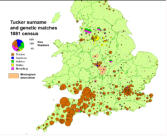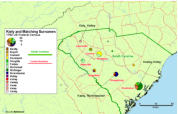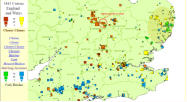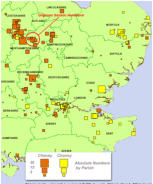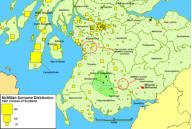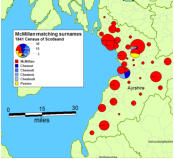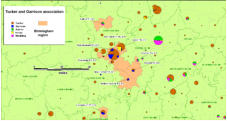
© J.H.Mathieson


Pseudoscience begins with a hypothesis—usually one which is appealing emotionally, and
spectacularly implausible—and then looks only for items which appear to support it. Rory
Coker, Ph.D. Quackwatch
Origenes is a commercial enterprise which markets case studies under the names "Irish Origenes",
"English Origenes" and "Scottish Origenes". Amazingly it claims it can locate the "Genetic
Homeland" of your ancestors where they first took their surname 1000 years ago with a simple
cheek swab. It should be noted from the outset that the DNA science behind claim has been called
into question by numerous DNA scientists and researchers.
Case study deficiencies:
Built into the methodology employed in the studies are two additional elements that can cause the
results to be inaccurate and frequently completely erroneous.
·
the reliance on farmers as an identifier for the test subjects "genetic homeland".
·
rudimentary mapping techniques used to identify the "genetic homeland"
The case studies are based on the assumption that the distribution of farmers extracted from the
census can be used to identify a genetic homeland. This presumes that your genetic ancestors
continue to farm the same land for 1000 years, approximately 30 generations. To my knowledge the
claim of farmer persistence has never been demonstrated by Origenes, nor has the claim ever been
scientifically validated. The foundation of the idea is based on the pioneering work of H.P. Guppy
who did not draw the type of inferences made in the Origenes studies. No accredited genealogist,
historian or demographer would endorse this premise.
The article Can the Distribution of 19th Century Farmers Be Used To Identify a Surname's Genetic
Homeland? addresses the likelihood of surnames persisting on the same land for 1000 years or
more.
In addition to questionable DNA analysis, and the problematic use of farmers, the case study
conclusions are presented with manually generated Google Earth maps on which pins are placed to
represent the distribution of farmers, and by inference, the surname's distribution. However the
Origenes studies ignore the more complex realities of surname distributions. To truly understand the
nature and intricacies of a surname's distribution and the surnames possible origin, one must study
the distribution in it's entirety. This can be an extremely time consuming and labour intensive
process which involves specialized knowledge and software, neither of which are evident in
Origenes studies. The studies also avoid using historical records (other than the census) believing
that the DNA methodology stands on its own. The author has often trumpeted the phrase "DNA
doesn't lie" to which it might simply be said; "yes but it doesn't always tell the whole truth".
The following four summaries of more detailed reviews point out the typical shortcomings of
Origenes studies. The reviews are drawn from English, Irish and Scottish case studies to provide
representative samples. (each case study can be viewed in it's entirety by following the blue links)
The English Tucker Case Study
The first case study concerns the Tucker surname in England. The claim made in the study was
that:
The Surname distribution of Tucker and Garrison show an
association with Devon. The surname Tucker and some
Garrison’s share close ancestry based on the high numbers of
individuals that occur as genetic matches. Both of these
surnames overlap only in Cornwall and Devon. The Genetic
Homeland of the English Tucker is to be found in Devon and
Cornwall
A thorough examination of the 1881 census would show that the Garrison association in Devon and
Cornwall referenced above, was with a single Garrison individual, in this case a young girl residing
at the time with relatives in Devon. Her birth place was actually in Gloucestershire and of course
females do not carry the Y chromosome referenced in Origenes studies. The conclusion of the
study is absurd, but demonstrates the superficiality of the Origenes methodology. Tucker is a
common occupational surname with scores of independent origins. Had English Origenes been
capable of undertaking a detailed map study or taken the
time to check the actual census records, the matching
surnames would have all be shown to localize in the
industrial region of Birmingham, not in Devon or Cornwall.
Additionally It is highly likely the surname matches
represent non paternity events, not relationships that
occurred more than 1000 years ago.
The Irish Kiely Case Study
The foundation of the Origenes method is to identify areas where related surnames overlap. But
what if the surnames can't be shown to overlap? This was the conundrum faced by Origenes in the
Kiely study. Most of the matching names appeared to be English or Scottish, not Irish. Farmers of 4
of the 40 matching surnames could be show to concentrate in the vicinity of Royal Leamington Spa
in the Midlands of England. However there were no Kielys to be found in or near the cluster of
matching surnames. The author explains this problem away with a version of the old adage that
"the absence of evidence is not evidence of absence":
“It may well be that the Kiely surname did arise in England near Royal Leamington Spa
but that all of the Kiely’s departed for Ireland with the Normans and settled in the
southwest".
The author should have been aware, that despite not being "Irish
surnames", 34 of the 40 matching surnames in the DNA test results,
including the four used in the study, could be found in Ireland, and
26 of those in northern Ireland. More noteworthy was the fact that
two of the matching surnames, Lantz and Rickinbacker, were
obviously German. In the 18th century the Scots Irish and Germans
followed the same migration paths as they emigrated and settled in America. The terminus of the
Great Wagon Road, central to this migration, was South Carolina. The first census of the United
States was taken in 1790. Had this census been consulted the author would have found the Kaely
and Rickinbacker surname in Orangeburg county South Carolina. Additionally 10 of the rarer
matching surnames could also be identified in South Carolina. The
matching surnames may have arrived in South Carolina as a result of
the early 18th century Scots Irish migration to America . The Kielys
found in the south of Ireland may also have emigrated to South
Carolina much earlier, possibly during the Cromwellian expulsions of
the 17th century.
The Chaney Case study
The Chaney case study demonstrates a clear lack of understanding of the structure, complexity and
history of English surnames. In the case study there were a number of
related variants that had to be considered. Chaney was clearly a minor
variant of Cheney. It had a distinct distribution which was spatially isolated
from the major Cheney distribution. Again because of the inability to map
at a high resolution, and the use of a small subsets of data, the author
was unaware of this surname complexity. The study mistakenly presumed
the two surnames were not variants but simply one and the same.
Supporting this speculation is the fact that place name evidence in
Northamptonshire where the genetic homeland was presumed to be, and
which clearly referenced the Cheney name, was assumed to refer to the
Chaney surname which was absent from the area.
The case crumbles when the distribution of the Chaney and key matching surnames, Cady and
Hatcher, are mapped together. Rather than Northamptonshire where
none of the matching surnames could be found, and where Origenes
claimed the homeland could be identified, they were found to cluster
on the coastal border of Norfolk snd Suffolk.
The Scottish McMillan case study
The Scottish McMillan study amplifies many of the shortcomings evident in the previous studies.
In this instance matching surnames are cherry picked from a long Ysearch list. Four of the thirty two
matching surnames were known to be at least partially localized in
the borders of Scotland and on this basis the border region was
identified as the surname homeland. However a much stronger
case could be made for northern Ayrshire where 22 of the 32
surnames from the Ysearch list could also be be found. Again
reliance on the limited farmer evidence lead the study to conclude
that the coincidence of two Chesney farmers with three McMillan
farmers was sufficient evidence to conclude Mr. McMillan's
ancestors had resided in the area for 1000 or more years. Truly remarkable. If genealogy was only
that easy.
Again had the entire distribution of surnames been mapped at the parish level two critical
observations would have become clear. With the exception of the two Cheney farmers none of the
other matching farmers used in the study are found in the genetic homeland as inferred in the
study.
A detailed spatial analysis of the surname distributions would have
pointed to the single parish of Kilmarnock in Ayrshire where the case
study's matching surnames and rare surnames from the actual test
results were found to localize.
General observations
The reviews have lead me to conclude that the fundamental
inadequacies inherent in the reports are such that the chances of getting it "right" are a risk not
worth taking. The price of joining the Origenes club, is listed at $200, which includes a series of wall
maps. If you think the maps are worth the price of admission to the "club", by all means join, but
don't expect the advise will actually solve those nagging brick walls.
Origenes Case Studies Reviews
